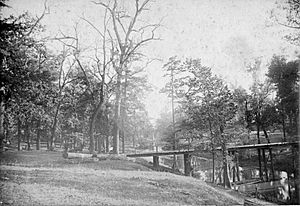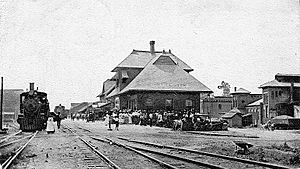Clarksdale, Mississippi facts for kids
Quick facts for kids
Clarksdale, Mississippi
|
|||
|---|---|---|---|
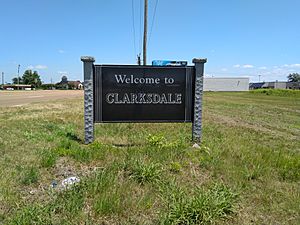 |
|||
|
|||
| Nickname(s):
The Golden Buckle on the Cotton Belt
|
|||
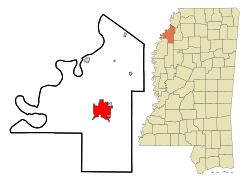
Location of Clarksdale, Mississippi
|
|||
| Country | United States | ||
| State | Mississippi | ||
| County | Coahoma | ||
| Area | |||
| • Total | 18.79 sq mi (48.67 km2) | ||
| • Land | 18.79 sq mi (48.67 km2) | ||
| • Water | 0.00 sq mi (0.00 km2) | ||
| Elevation | 174 ft (53 m) | ||
| Population
(2020)
|
|||
| • Total | 14,903 | ||
| • Density | 793.01/sq mi (306.18/km2) | ||
| Time zone | UTC−6 (Central (CST)) | ||
| • Summer (DST) | UTC−5 (CDT) | ||
| ZIP Codes |
38614, 38669
|
||
| Area code(s) | 662 | ||
| FIPS code | 28-13820 | ||
| GNIS feature ID | 0666084 | ||
| Website | Clarksdale, Mississippi | ||
Clarksdale is a city in Coahoma County, Mississippi, United States. It's the main city of the county. You can find it along the Sunflower River. The city is named after John Clark, who started it in the mid-1800s. He opened a timber mill and other businesses there.
Clarksdale is in the Mississippi Delta area. It's known as a center for farming and trade. Many African-American musicians helped create the blues music style here. This special American music then spread to cities like Chicago during the Great Migration.
The Clarksdale area, including all of Coahoma County, is part of a larger region. This region is now connected to the Memphis and Forrest City areas. Together, they form a large area with about 1.4 million people. The Mississippi River forms the western edge of the county.
Contents
History of Clarksdale
Early Beginnings
Long ago, the Choctaw and Chickasaw Native American tribes lived in the Delta region. Clarksdale grew where two old Native American paths met. One path went from Georgia to New Mexico. The other went northeast to a village near what is now Pontotoc, Mississippi.
In 1830, the Choctaw people signed a treaty. They agreed to move from their lands in Mississippi. They moved to an area called Indian Territory, which is now Oklahoma. The Chickasaw Nation also moved there in 1837.
After the Native Americans moved, European-American settlers came to the Delta. The rich soil was perfect for growing cotton. These settlers brought or bought African Americans who were forced into slavery to work on the cotton farms. These farms were often built near rivers for easy transport.
John Clark started the town in 1848. He bought land and began a timber business. He was related to James L. Alcorn, a big cotton farmer and politician. Clarksdale grew quickly because of the cotton trade. It was even called "The Golden Buckle on the Cotton Belt."
African Americans who were enslaved did most of the hard work on the cotton farms. They helped create the wealth from cotton in Mississippi. In 1860, Coahoma County had many more enslaved people than white residents.
After slavery ended, many Black families worked as sharecroppers. This meant they farmed land owned by others and shared the crops. They had some freedom but often faced unfair deals. During the Reconstruction Era after the Civil War, new laws helped Black people and poor white people. These laws allowed more people to vote and created the state's first public schools.
However, these changes didn't last long. Some white groups tried to stop Black people from voting. By 1875, white leaders took control of the state government. They passed Jim Crow laws, which separated public places by race.
Clarksdale was officially made a town in 1882. This happened after a railway was built through the town in 1879. The town's streets were planned in 1886, but they weren't paved until 1913.
African Americans continued to do most of the farm work until the 1940s. Then, machines started doing more of the work. Thousands of Black people left Mississippi during the Great Migration. They moved to cities like Chicago and on the West Coast. They took their rich musical traditions, which influenced jazz and blues music.
The Great Migration's Impact
Many people moved both to and from Clarksdale throughout its history. Before 1920, cotton farms in the Delta needed many workers. So, many Black families moved there to work as sharecroppers. After World War I, farm owners even encouraged Black people from other parts of Mississippi to come to the Delta.
By this time, Clarksdale also had people from Lebanon, Italy, China, and Jewish communities. They came as merchants and traders. But by 1920, the price of cotton dropped. Many Black people in the Delta started to leave. The Illinois Central Railroad had a big station in Clarksdale. It offered a route to Chicago for those looking for better jobs in the North. This became the main way many people left.
In the 1940s, three things caused more African Americans to leave Clarksdale. First, machines could now pick cotton. This meant fewer farm workers were needed. (A machine that could pick cotton was perfected nearby in 1946.) Second, many African American soldiers returned from World War II. They found it hard to find jobs in the Delta. Third, there were more challenges due to racial unfairness.
The "Great Migration" to the North was a huge movement of people in U.S. history. A famous book, The Promised Land, tells this story, connecting Clarksdale with Chicago and Washington D.C. The History Channel made a documentary based on the book. It was narrated by actor Morgan Freeman, who also owns a blues club in Clarksdale.
Recent Times
Clarksdale's citizens are known for their work in civil rights. On May 29, 1958, Martin Luther King visited Clarksdale. It was for a big meeting of the Southern Christian Leadership Conference (SCLC). In 1960, Aaron Henry, a local pharmacist, became the state president of the NAACP. He organized a two-year boycott of businesses in Clarksdale. In 1962, King visited Clarksdale again. He encouraged a crowd of 1,000 people to stand up for their rights.
Geography
Clarksdale is located on the banks of the Sunflower River. This is in the Mississippi Delta region.
The city covers about 13.9 square miles (36 square kilometers). Almost all of this area is land.
Population Information
| Historical population | |||
|---|---|---|---|
| Census | Pop. | %± | |
| 1890 | 781 | — | |
| 1900 | 1,773 | 127.0% | |
| 1910 | 4,079 | 130.1% | |
| 1920 | 7,552 | 85.1% | |
| 1930 | 10,043 | 33.0% | |
| 1940 | 12,168 | 21.2% | |
| 1950 | 16,539 | 35.9% | |
| 1960 | 21,105 | 27.6% | |
| 1970 | 21,673 | 2.7% | |
| 1980 | 21,137 | −2.5% | |
| 1990 | 19,717 | −6.7% | |
| 2000 | 20,645 | 4.7% | |
| 2010 | 17,962 | −13.0% | |
| 2020 | 14,903 | −17.0% | |
| U.S. Decennial Census | |||
2010 Census Data
In 2010, there were 17,962 people living in Clarksdale. About 79% were African American. Around 19.5% were White. Other groups included Asian, Native American, and people of two or more races. About 0.9% of the population was Hispanic or Latino.
2020 Census Data
| Race | Num. | Perc. |
|---|---|---|
| White | 2,155 | 14.46% |
| Black or African American | 12,144 | 81.49% |
| Native American | 12 | 0.08% |
| Asian | 98 | 0.66% |
| Other/Mixed | 290 | 1.95% |
| Hispanic or Latino | 204 | 1.37% |
In 2020, Clarksdale had 14,903 people. There were 5,847 households and 3,808 families living in the city.
Arts and Culture
Delta Blues Museum
The Delta Blues Museum started in 1979 at the Carnegie Public Library. Sid Graves, the library director, worked hard to create the museum. He even stored displays in his car when there wasn't enough space!
The rock band ZZ Top discovered the museum by chance. This brought national attention to the museum. In 1995, the museum grew to take up a large part of the library. Later, in 1997–1998, the museum moved to a renovated train depot. This became its permanent home.
Mississippi Blues Trail Markers
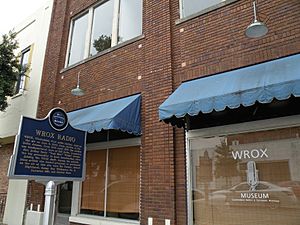
Several Mississippi Blues Trail markers are in Clarksdale. These markers tell the stories of blues music and musicians. One marker is on Stovall Road. It's at a cabin where Muddy Waters is believed to have lived. He worked on a large cotton farm there before moving to Chicago.
Another marker is at the Riverside Hotel. This hotel was a place where blues musicians stayed when they traveled through the Delta. In 2009, a marker for Clarksdale native Sam Cooke was placed in front of the New Roxy Theater.
Clarksdale Walk of Fame
The Clarksdale Walk of Fame began in 2008. It features plaques in downtown Clarksdale. These plaques honor famous people from the city. Some of the people honored include John Lee Hooker, Ike Turner, Muddy Waters, and Sam Cooke.
Education
Community Colleges
Coahoma Community College is located just north of Clarksdale. It is a college that historically served Black students.
Public Schools
The Clarksdale Municipal School District serves the city. It has nine schools, including Clarksdale High School. About 3,600 students attend these schools. In the 1960s, Clarksdale was the first school district in Mississippi to begin integrating its schools.
Coahoma Early College High School is a public high school not part of the city district. It is on the campus of Coahoma Community College.
Coahoma County Junior-Senior High School is also in Clarksdale. However, it serves students from outside the city limits.
Private Schools
Clarksdale has three private schools:
- Lee Academy
- Presbyterian Day School
- St. Elizabeth's Elementary School
Charter School
Clarksdale Collegiate Public Charter School opened in 2018. It plans to teach students from kindergarten through 8th grade.
Media
Newspapers
- Clarksdale Press Register
Radio Stations
- WAID (FM)
- WROX (AM)
- WCQC (FM)
- XRDS (FM)
Notable People
Born in Clarksdale
- Robert E. Bacharach – A judge for a U.S. Court of Appeals.
- Lerone Bennett Jr. – A writer and historian.
- Charles L. Sullivan – A politician, lawyer, and pilot.
- Larry A. Thompson – A film producer and author.
- Wright Thompson – A sports writer for ESPN.
- W. Harry Vaughan – Founded the Georgia Tech Research Institute.
- Baseball players: Matt Duff, Cleo James, Fred Valentine.
- Football players: Charlie Conerly, Terrence Metcalf, Mario Haggan, Elgton Jenkins.
- Basketball players: Earl Barron, Earnie Killum.
- Boxers: Eddie Perkins, Alfonso Ratliff.
- Musicians: Eddie Boyd, Jackie Brenston, Sam Cooke, Nate Dogg, Earl Hooker, John Lee Hooker, Son House, Christone "Kingfish" Ingram, Junior Parker, Rick Ross, Ike Turner, Robert "Bilbo" Walker Jr..
- Earl D. Shaw – A physicist known for laser technology.
Lived or Worked in Clarksdale
- Marshall Bouldin III – A portrait artist.
- Earl L. Brewer – A former Governor of Mississippi.
- Gus Cannon – A musician.
- Morgan Freeman – An Academy Award-winning actor.
- W. C. Handy – A famous musician.
- Aaron Henry – A civil rights leader.
- Robert Johnson – An important Delta blues musician.
- Willie Morganfield - A gospel musician.
- Jack Robinson – A photographer.
- Frank Stokes – A musician.
- Wade Walton – A musician and barber.
- Muddy Waters – A blues musician.
- Tennessee Williams – A famous playwright.
- Early Wright – A radio personality.
See also
 In Spanish: Clarksdale (Misisipi) para niños
In Spanish: Clarksdale (Misisipi) para niños





